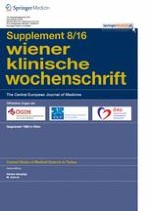01.12.2016 | original article
The effects of Nigella sativa oil, thymoquinone, propolis, and caffeic acid phenethyl ester on radiation-induced cataract
Erschienen in: Wiener klinische Wochenschrift | Sonderheft 8/2016
Einloggen, um Zugang zu erhaltenSummary
Background
The aim of this study was to investigate the antioxidant and radioprotective effects of propolis, caffeic acid phenethyl ester (CAPE), Nigella sativa oil (NSO), and thymoquinone (TQ) against ionizing radiation-induced cataracts in lens after total cranium irradiation of rats with single dose of 5-Gy cobalt-60 gamma rays.
Methods
A total of 74 Sprague–Dawley rats were divided into 8 groups to test the radioprotective effectiveness of Nigella sativa oil, thymoquine, propolis, or caffeic acid phenethyl ester administered by either orogastric tube or intraperitoneal injection. Appropriate control groups were also studied.
Results
Chylack’s cataract classification was used in the study. At the end of the tenth day, cataracts developed in 80 % of the rats in the radiotherapy group. After irradiation, cataract rate dropped to 20 % in NSO, 30 % in propolis, 40 % in CAPE, and 50 % in TQ groups and was limited to grade 1 and grade 2. Cataract formation was observed the least in NSO group and the most in TQ group. In the irradiated (IR) group, superoxide dismutase activity was lower, while glutathione peroxidase and xanthine oxidase activities and malondialdehyde level were higher compared with the other groups. Total superoxide scavenger activity and nonenzymatic superoxide scavenger activity were not statistically significant in IR group compared with the other groups.
Conclusions
The findings obtained in the study might suggest that propolis, CAPE, NSO, and TQ could prevent cataractogenesis in ionizing radiation-induced cataracts in the lenses of rats, wherein propolis and NSO were found to be more potent.
Anzeige
